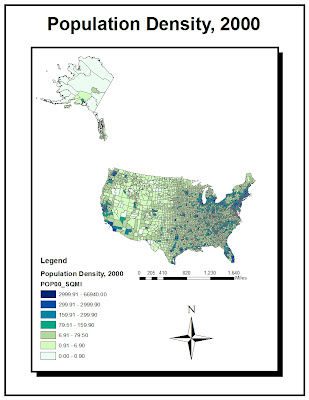Using GIS I have created a reference map to show where the fire burned and how it changed over time in Los Angeles County. By looking at the map you can see the shaded releif model shows that the fire gre rapidly in the first week. On the August 29th about 7,000 acres had burned and by September first well over 100, 000 acres had burned. Fire fighters struggled to contain the fire in the first week as flames reached over 200ft and the fire was creating its own wind patterns making it unpredictable and allowing it to crow to 100,000 acres in the first week.
In my reference map I have provided all the major highways in the area around the fire. During the time of this rapidly growing fire nearly 100,000 people were asked to evacuate their homes on a very short notice, while nearly all of them complied knowing the danger of this unpredictable fire. A map like this reference one can allow the state to block off highways that first of all are in threat by the fire but also the highways that need to be used for the full evacuation of the areas affected by the fire.
Here I above I have created a thematic map to reinforce or make easier the evacuation plans for certain regions and which highways to take. Glendale, Altedena, Littlerock, and Acton were all neighborhoods of LA that had be evacuated because the threat of the fire. In this map you can link each one of these neghborhoods to the closest highways, then block that highway from a certain point for the fastes possible evacuation of these thousands of people. When a fire like this breaks out firefighters have little time to evacuate regions in threat and for safety more people are usually evacuated than neccessary. You can see from this map above that it probaly would have been a good idea to evacuate the cities on the south-west part of the fire on highway 210 and then shut down 210 especially the southern part that runs close to the fire.
Also through this thematic map you can see that I have provided all the bodies of water nearby the fire. You can see from the map that all the bodies of water are surrounding the fire, Indicating how dry the land is on the inside. So these bodies of waters almost outlining the fire seem like they prevented it from spreading even further.
When an emercengcy situation or natural disaster of some sort breaks out like a the fire GIS is often called upon for many diffrent resoucres. To find the easiest evacuation routes for each region, the closest hospitals, schools, or urbanized areas that are in danger, and various of other resources and information to be provided for the safety of people and the community. In my maps I gave an example of what GIS could have provided in a very quick response to the fire growing to get people to safety as quick as possible and which regions needed to be moved the fastest.
References
"'Angry Fire' Roars
across 100,000 California Acres." CNN. CNN, 31 Aug. 2009. Web. 10 June 2012.
http://articles.cnn.com/2009-08-31/us/california.wildfires_1_mike-dietrich-firefighters-safety-incident-commander?_s=PM:US.
Staff. (2009, August 31). L.A.County fire doubles in size; more homes destroyed; Mt. Wilson threatened. Los Angeles Times. Accessed August 31, 2009.
Michon, Scott. "Earth Observatory." Earth Observatory. n. page. Print. http://earthobservatory.nasa.gov/IOTD/view.php?id=40011.
n. page. Print. http://www.fire.ca.gov/about/downloads/20LACRES.pdf.
Archibold, Randal C.
"After a Devastating Fire, an Intense Study of Its Effects." The New York Times.
3 Oct. 2009. Web. 10 June 2012. http://latimesblogs.latimes.com/lanow/2009/08/la-county-fire-doubles-in-size-more-homes-list-mt-wilson-threatened.html.



















